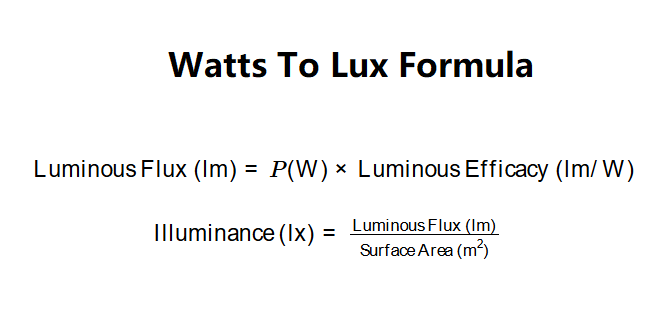1. What is a Watts to Lux Calculator?
Definition: This calculator computes the illuminance in lux (lx) by converting electrical power in watts (W) to luminous flux in lumens (lm) using the luminous efficacy of a light source, then dividing by the surface area.
Purpose: It is used to estimate the brightness (illuminance) of a light source on a surface, helping in lighting design for homes, offices, or outdoor spaces.
2. How Does the Calculator Work?
The illuminance is calculated using:
\( \text{Luminous Flux (lm)} = P(\text{W}) \times \text{Luminous Efficacy (lm/W)} \)
\( \text{Illuminance (lx)} = \frac{\text{Luminous Flux (lm)}}{\text{Surface Area (m}^2\text{)}} \)
Where:
- \( P(\text{W}) \) is the power in watts (W)
- \( \text{Luminous Efficacy (lm/W)} \) is the efficiency of the light source in lumens per watt
- \( \text{Surface Area (m}^2\text{)} \) is the area illuminated
Steps:
- Enter the power (\( P \)) and select a unit (mW, W, kW, MW, GW)
- Select the light source or enter a custom luminous efficacy (lm/W)
- Enter the surface area in square meters (m²)
- Convert power to W
- Calculate luminous flux using \( \text{Luminous Flux} = P \times \text{Luminous Efficacy} \)
- Calculate illuminance using \( \text{Illuminance} = \text{Luminous Flux} / \text{Area} \)
Display format:
- If a value is > 10000 or < 0.0001 (and not zero), use scientific notation (e.g., \( 1.23456e-3 \))
- Otherwise, display with 5 decimal places
3. Importance of Watts to Lux Calculation
Details: This calculation helps determine the brightness of a light source on a surface, which is crucial for designing lighting systems that meet specific illumination requirements, such as in offices, homes, or public spaces.
4. Using the Calculator
Tips: Ensure all inputs are positive. Select the appropriate light source to use its typical luminous efficacy, or enter a custom value if known. The surface area should represent the area directly illuminated by the light source.
Examples:
- Example from Image: \( P = 10 \, \text{W} \), Light Source = Mercury Vapor (35-65 lm/W, average 50 lm/W), Area = 1 \, \text{m}^2 \):
- \( \text{Luminous Flux} = 10 \times 50 = 500.00000 \, \text{lm} \)
- \( \text{Illuminance} = 500 / 1 = 500.00000 \, \text{lx} \)
- LED Bulb in a Room: \( P = 15 \, \text{W} \), Light Source = LED Bulbs (80-120 lm/W, average 100 lm/W), Area = 10 \, \text{m}^2 \):
- \( \text{Luminous Flux} = 15 \times 100 = 1500.00000 \, \text{lm} \)
- \( \text{Illuminance} = 1500 / 10 = 150.00000 \, \text{lx} \)
- Custom Efficacy: \( P = 100 \, \text{W} \), Luminous Efficacy = 90 \, \text{lm/W}, Area = 5 \, \text{m}^2 \):
- \( \text{Luminous Flux} = 100 \times 90 = 9000.00000 \, \text{lm} \)
- \( \text{Illuminance} = 9000 / 5 = 1800.00000 \, \text{lx} \)
5. Frequently Asked Questions (FAQ)
Q: What is lux?
A: Lux (lx) is a unit of illuminance, measuring the amount of light (luminous flux) per unit area, in lumens per square meter (lm/m²).
Q: What is luminous efficacy?
A: Luminous efficacy measures how efficiently a light source converts electrical power into visible light, expressed in lumens per watt (lm/W).
Q: Why does the light source matter?
A: Different light sources have different luminous efficacies, affecting how much light they produce per watt of power. For example, LED bulbs are more efficient than incandescent bulbs.
Watts to Lux Calculator© - All Rights Reserved 2025
 Home
Home
 Back
Back
